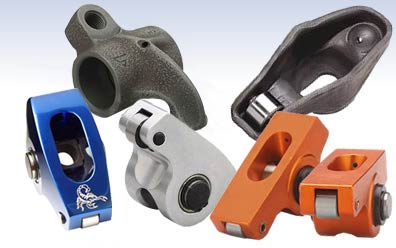Rocker arms are among the most stressed components in your engine—and the most important, too. They’re essentially tasked with transferring movement from the camshaft lobes to the valves, making them a key cog in your engine’s power production.
So are you getting optimum performance from your rocker arms?
According to the valvetrain experts at COMP Cams, there are three basic modifications or upgrades you can make to your rocker arms to achieve more horsepower.
Increase Rocker Arm Ratio
Camshaft lift x rocker arm ratio = valve lift.
By increasing the rocker arm ratio in this equation, you can effectively increase valve lift without swapping out your camshaft. For example, switching from a 1.5 to 1.6 ratio on a small Chevy or stepping to 1.8 ratio on a Ford application will yield a greater valve lift.
How does that affect performance and power?
As we told you in our Cam Glossary 2.0 post, valve lift tells us how much the valves are opening and determines the amount of power-building airflow getting into the engine. This has a direct effect on how much power and torque your engine will produce. In general, higher lift will produce more mid- and high-rpm power.
For more technical information on rocker arm ratio and its influence on performance, we’d recommend you check out this earlier video post on rocker arm ratio.
When choosing a rocker arm ratio, it’s important to follow the camshaft manufacturer’s recommendations to avoid potential clearance issues and ensure your other valvetrain components are suited to your desired valve lift.
Make the Rocker Arms Stiffer
Flex at the rocker arm mounting point, or within the rocker itself, and can lead to power loss. Deflection, or the unwanted movement within the rocker arm, will cause the energy to be transferred to the valves at a slower pace. More importantly, flex within the rocker arm can lead to fatigue and premature failure. You can make your rocker arms stiffer by opting for steel rockers. Steel is less prone to flex and is generally regarded as more durable; however, it is heavier than aluminum so there is a trade-off.
More on that in a bit.
Another way you can stiffen up your rocker arms is by changing the mounting point. Most rocker arms are mounted on studs, and you can increase rigidity with larger diameter screw-in style studs. For higher rpms and spring pressures—say, 7,000 rpm and above—you may want to step up to shaft-mount rockers.
Rather than being mounted on a stud, a shaft-mount setup utilizes a horizontal shaft that works as the fulcrum. Ideal for racers, this design significantly increases the mounting stiffness, stabilizes the valvetrain, and ensures maximum energy is transferred to the valves instantly. The result is maximum, intended lift for optimum airflow.
The downside to shaft-mount rockers is cost. Fortunately, you can use a stud girdle with your existing stud-mount rockers instead to increase rigidity and reduce flex. A stud girdle essentially acts as a large clamp and ties all your existing rocker arm studs together. It’s a relatively simple device and can be made of aluminum to alleviate weight concerns.
Decrease the Moment of Inertia
Moment of inertia is the rocker arms’ resistance to rotation.
The higher the moment of inertia measurement, the more valve spring pressure it takes to control the rocker arm instead of the valves. And this leads to loss of rpm and potential horsepower.
You can lower the moment of inertia by lightening the rocker arm’s weight, particularly at areas that are farther from the trunion. You can do this by removing mass at less critical areas of the rocker or by using a lighter weight material.
And that brings us back to that trade-off between steel and aluminum. Striking the right balance between weight and stiffness is among the biggest challenge when choosing rocker arms. COMP Cams cites lighter weight and superior heat dissipation as reasons for using aluminum rocker arms; stiffness and higher durability are reasons for using steel rockers.
To help bridge the divide between the benefits of steel and aluminum, many manufacturers now offer chromoly steel rocker arms. The chromoly steel material delivers superior rigidity yet weights considerably less than traditional stamped steel rockers—the best of both worlds.
Finally, we’d be remiss if we didn’t mention the well-documented benefits of roller rockers. The roller design reduces friction and produces less heat, especially at higher rpms.
It’s yet another way to foster maximum power with your rocker arms.


[…] more information on how rocker arm ratio relates to power and performance, take a look at this video from an earlier OnAllCylinders […]
Can rocker arms help with cam over lap. Surging is the big problem. Running Texas speed stage 3 LS7.
When considering increasing rocker ratio on a stock 289, how do I insure against coil binding? How much can I increase the ratio without hitting the stock pistons? I want reliability… what is the best choice of rockers? Thanks, J.